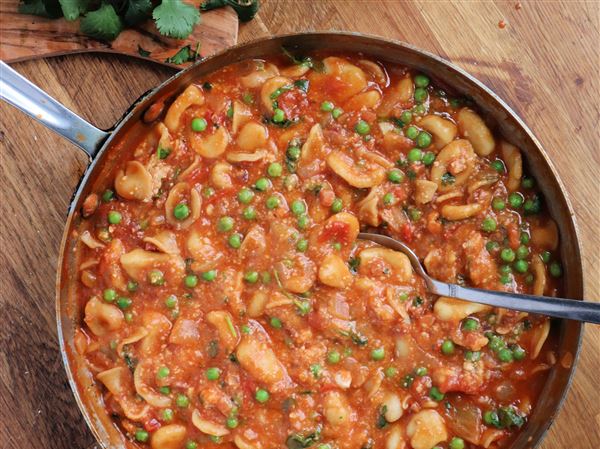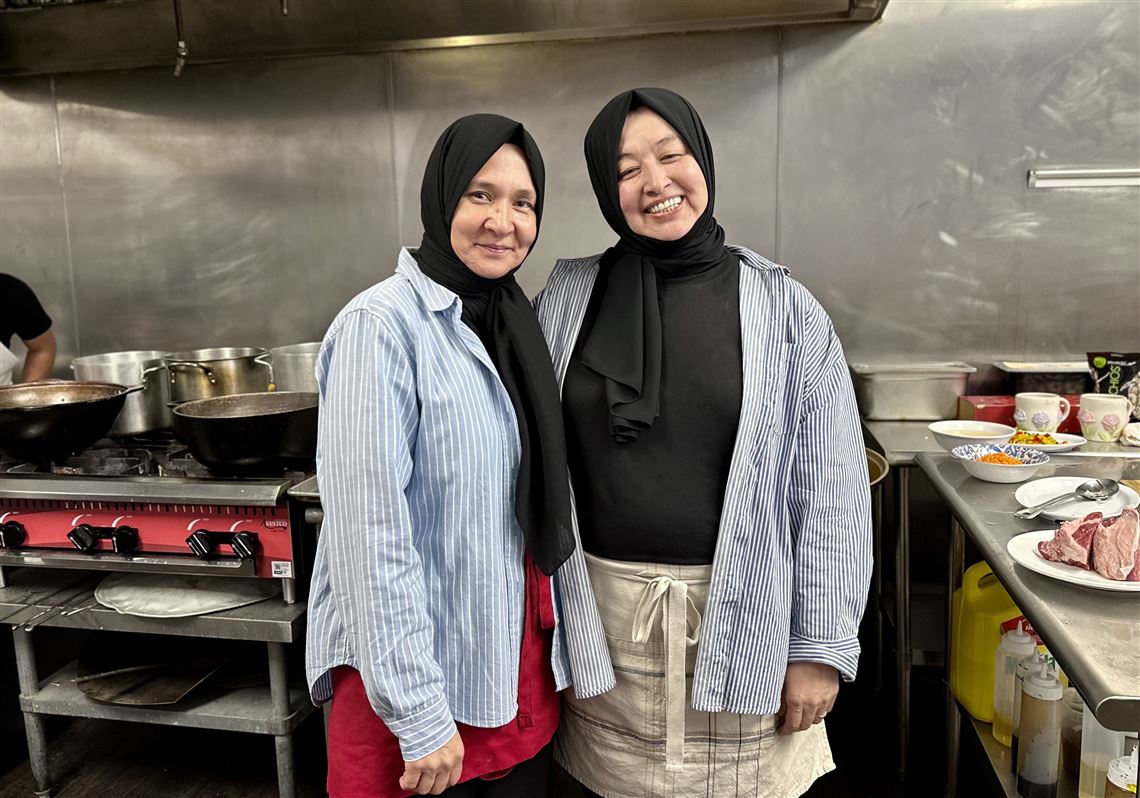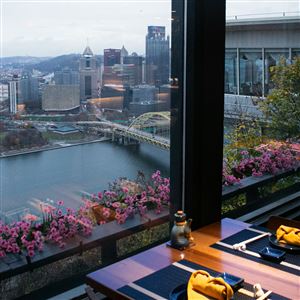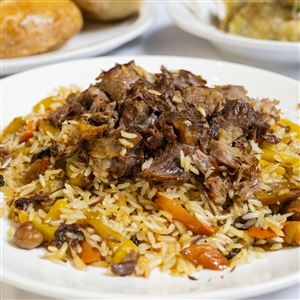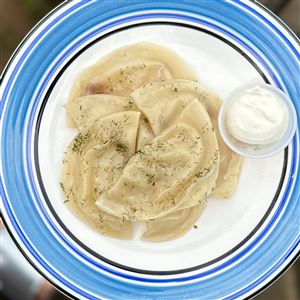Uzbek cuisine, once a rarity in Pittsburgh, is now capturing the city's curiosity. I caught the early ebb of the wave about a year ago as I began reporting for the fourth installment of our Pittsburgh Dumpling Project.
What I learned was that two seemingly ordinary pizza shops — Pizza Bella Monte in the West End and Downtown’s Pizza Bari — were gradually adding Uzbek dishes to feed people in their growing community. Over the past year or so, Bella Monte has dropped the pizza mantle entirely and rebranded as Chaykhana, while Pizza Bari has pushed its Uzbek menu more prominently as a slew of new, proudly front-facing restaurants opened.
The boomlet offers Pittsburgh an opportunity to embrace what might be considered one of the world’s original fusion cuisines — and one of its most delicious.
“Our cuisine isn’t as popular or understood as other countries’ foods,” said Dilnoza Yuldosheva, co-owner of Café Samarkand, Pittsburgh’s newest Uzbek restaurant. “It’s still developing in the United States, and now it seems like people in Pittsburgh are really starting to like it.”
So, what is Uzbek food?
Uzbekistan, a landlocked country in the heart of Central Asia, boasts a tapestry of flavors shaped by centuries of cultural exchange as a key trading stop on the ancient Silk Road. Merchants on caravans laden with spices, silk and other luxury goods left behind a culinary legacy that fused traditions from across Asia and Europe.
Its culinary heritage reflects influences from northern China, the Persian Empire, the Mongol Empire and, later, the Russian Empire and Soviet Union. The Chinese brought techniques for noodle-making and dumplings. Persian traders introduced aromatic spices, dried fruits and slow-cooked rice dishes that would evolve into Uzbekistan’s beloved plov. The Mongols left behind a deep tradition of lamb and dairy consumption, while centuries under Russian and Soviet rule introduced elements such as mayonnaise-based salads and hearty bread traditions.
“Uzbek cuisine is very mixed, just like American cuisine. Ours just goes back a few more years,” said Sarvar Abdurashidov, co-owner of Chaykhana in the West End and Piyola in Mt. Lebanon.
By the way, when he says “a few more years,” he means several thousand. Some cities, such as Samarkand, established in the seventh century BCE, are among the oldest continuously occupied settlements in Central Asia.
Since gaining independence in 1991, Uzbekistan has deepened its embrace of its long-standing Turkic roots, drawing culinary parallels with Turkey, Azerbaijan, Kazakhstan and Kyrgyzstan. Meals are communal, with large platters of food meant to be shared among family and friends.
What should I order?
Dumplings hold a cherished place in Uzbek fare, reflecting the nation's diverse gastronomic heritage. Pound for pound, Uzbekistan just might be the world’s most thrilling dumpling country due to those influences.
Manti are the showstoppers — fist-sized (or bigger) dumplings filled with beef or lamb, finely chopped onions and warming spices, then pinched at the top like a drawstring pouch before being steamed tender.
Potato-stuffed vareniki, reminiscent of pierogi, are typically served with plenty of butter and dill but without a whiff of cheese or kraut. You’ll find chuchvara and pelmeni, both of which resemble tortellini, often presented in broths or accompanied by sour cream, black pepper and dill.
“We put our dumplings in soups too, because soup is very essential to our food,” said Sultonmurod Dshbulatov, co-owner of Downtown’s Pizza Bari, while I was reporting for the Pittsburgh Dumpling Project.
Plov, Uzbekistan’s national dish, is where patience pays off in a big, hearty way. The aromatic rice dish, a relative of pilaf and pilau, is traditionally bolstered in richness with qurdiuq, the rendered tail fat of a breed of lamb raised in Central Asia for more than 3,000 years (though our restaurants look to Western Pennsylvania’s outstanding lambing region to infuse the grains).
The rice is layered with succulent chunks of lamb, matchsticks of golden carrots, plump chickpeas and just enough raisins or barberries to add a touch of sweetness, then seasoned with a heady mix of spices.
Northern China’s imprint on Uzbek cuisine is noticeable in its variety of hand-pulled and wide noodles. Lagman, often stir-fried with a robust mix of vegetables and meat, highlights the elasticity and chew of freshly stretched dough, while beshbarmak — more delicate and ribbon-like — plays a best-supporting role in soups, soaking up the flavors of slow-simmered broths.
Somsa (sometimes spelled samsa), a flaky hand pie golden and blistered from the blazing hot heat of an Uzbek tandoor oven, is filled with a mix of meat and onions or hearty vegetables such as pumpkin. Uzbekistan’s bread game is showcased with its nan, the round, slightly chewy bread stamped with intricate patterns before being slapped against the inner walls of a tandoor. It’s crisp at the edges, soft in the center and designed to be torn and dipped into anything on the table.
While kebabs aren’t at all unique to Uzbekistan, the deeply seasoned, flame-kissed and undeniably satisfying skewers are often a highlight at Uzbek restaurants.
Why now?
“People from everywhere should come try this, especially if they haven’t before. This is food that makes people very happy,” said Odil Mirsoatov, an employee of Pizza Bari, in 2023.
He moved to Pittsburgh in 2022 because of all the good things he heard about the city from his sister.
Mirsoatov’s decision to move from New York to Pittsburgh reflects one of the city's newest immigrant waves. There has been a small Uzbek population here for more than a decade and, for most of that time, Kavsar, which opened on Mount Washington in 2014, was the region’s only Uzbek restaurant.
Abdurashidov estimates the region’s current Uzbek population to be as high as 4,000 to 5,000 people, though no official data exists on the population boom. Many were drawn here from bigger cities such as New York and Philadelphia for the comparatively inexpensive cost of living and to find jobs in shipping, rideshare driving and delivery for third-party apps.
Where should I go?
There are eight Uzbek restaurants in the Pittsburgh metropolitan area. Note that all adhere to halal dietary laws, which include a prohibition on drinking alcohol. Tea is the beverage of choice.
Chaykhana: About a year ago, Sarvar Abdurashidov decided to go all in and rebrand his West End pizzeria, Pizza Bella Monte, as Chaykhana after a year or so of serving low-key offerings to Uzbek drivers. His bright West End dining room is enlivened with artificial flowers and long tables perfect for celebratory gatherings. Among my favorite dishes are the chewy, springy lagman and the light, uplifting pelmeni soup. The handmade desserts are terrific too. 410 S. Main St., West End; chaykhanapittsburgh.com
Piyola: Last year, Abdurashidov and his business partner, Akmal Ikromov-Conow, stepped things up with the splashy opening of Piyola in Mt. Lebanon. Service is upbeat in the white-tablecloth dining room — Abdurashidov says his goal is to make you feel like an honored guest in an Uzbek home. Look for juicy kebabs, luxurious beshbarmak and sunny eggplant spread. Piyola is one of the Post-Gazette’s Best New Restaurants of 2024. 663 Washington Road, Mt. Lebanon; piyolapittsburgh.com
House of Shish Kebabs: Dilmurod Sarkarov, a Pittsburgh resident since 2005, used to drive six hours to New York City to get a taste of home. Like many other Uzbek restaurant owners, he operated a pizza joint before jumping into the restaurant trade in September.
His casual, bare-bones House of Shish Kebabs is a portal into Uzbek street food. (“It’s like the nostalgia of going to Fiori’s for a Pittsburgher,” Sarkarov says.) The Spring Garden establishment offers my favorite somsa and a delicious take on cuhot hurak (chickpeas with meat). Ask for the daily special too. 1926 Spring Garden Ave., Spring Garden; uzbekfood.net
Pizza Bari: Khurshid Toshpulatov and Sultonmurod Dshbulatov opened Pizza Bari in 2022 to offer Pittsburgh’s Muslim communities pizza prepared according to halal dietary laws. They added an “ask for it” menu of Uzbek dishes, which has since become a fixture in the festive dining room. A Pizza Bari bonus: The Downtown restaurant is open late: 1 a.m. during the week and 2 a.m. on weekends. 955 Liberty Ave., Downtown; pizzabaripgh.com
Vinny’s Pizza: You’d never know Vinny’s Pizza in Brookline moonlit as an Uzbek restaurant unless someone tipped you off. (Hi, I’m tipping you off.) The walls at the two-table spot are decorated with vintage Pittsburgh sports memorabilia, and the menu covers everything you’d expect from a takeout and delivery pizza joint, with nary a somsa or plov listed on it.
Yet if you ask the cashier, “What Uzbek dishes are available today?,” he’ll recite a list of the daily specials. Shurpa (sometimes sho'rva) is an Uzbek take on a soup with a gorgeous lamb and tomato broth rich with dill drawing from Persian, Central Asia and eastern European cooking; big chunks of potato, slices of carrots and chickpeas bob with rich chunks of lamb. Vinny’s also makes my favorite Uzbek nan. 618 Brookline Blvd., Brookline
Kavsar Uzbek Halal Restaurant: The original Pittsburgh Uzbek spot on a residential street in Mount Washington has the deepest menu to explore. You’ll find an outstanding collection of soup (borscht and ugra are two of my favorites), dumplings galore and an excellent plov. Owners Hayrullo Umaraliev and Tahmina Umaralieva updated their dining room in autumn. 16 Southern Ave., Mount Washington; kavsar.info
Caravan Halal Restaurant: The Downtown restaurant covers all the bases when it comes to Uzbek dining. 10 Smithfield St., Downtown; caravanhalalrestaurant.com
Cafe Samarkand: Pittsburgh’s newest Uzbek restaurant is run by a retired anesthesiologist, Khoshimjon Yuldoshev, who moved to the region two years to be closer to his two daughters and five grandkids. Look for a relaxed atmosphere in the Brookline dining room, where Yuldoshev is a gregarious presence. Cafe Samarkand’s gorgeous plov with plump rice savory from a dose of lamb fat, tender lamb, sweet raisins and lusty yellow carrots garnished with quail eggs, cherry tomatoes and lemon slices, is a must-get. The crackling somsa and tender dumplings are highlights too. 3103 Banksville Road., Banksville; cafesamarkand.com
First Published: March 16, 2025, 9:30 a.m.
Updated: March 17, 2025, 2:59 p.m.






